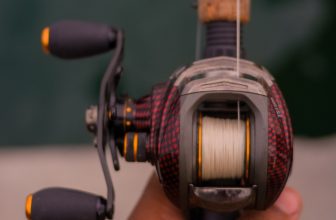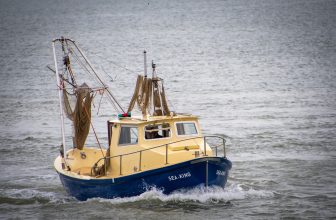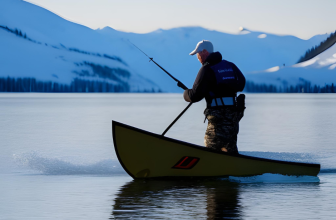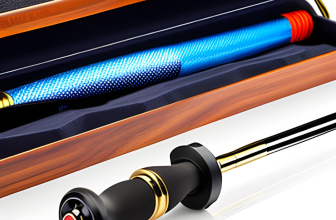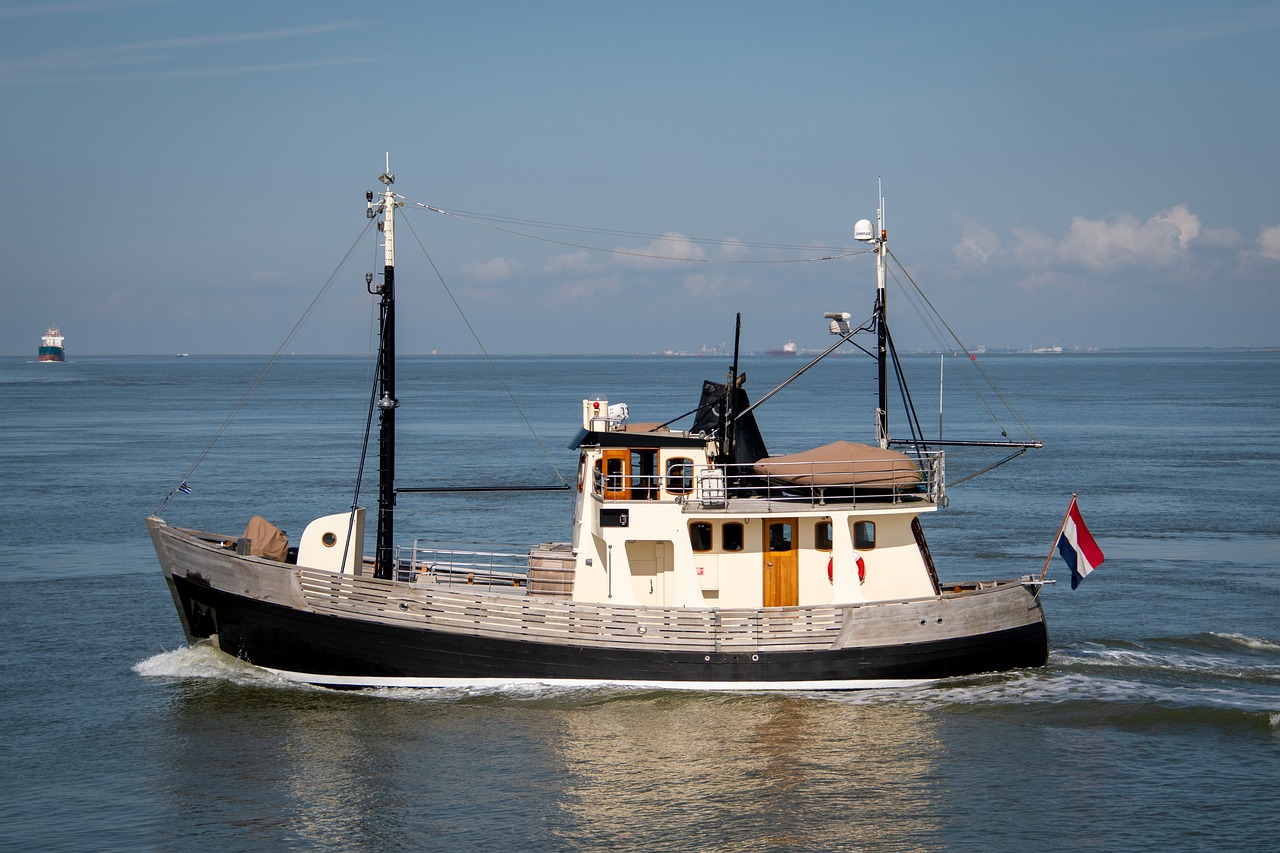
When you’re out on the water, it’s not uncommon to come across a fishing boat. Whether you’re cruising in your own vessel or paddling in a kayak, it’s important to know how to handle these encounters.
Fishing boats have specific needs and safety concerns, and as someone sharing the water with them, it’s your responsibility to be respectful and cautious.
In this article, we’ll discuss what you should do if you encounter a fishing boat while out on the water. From giving way to maintaining a safe distance, we’ll cover the best practices for sharing the water with fishing vessels.
By following these guidelines, you’ll help ensure a safe and enjoyable experience for everyone involved. So, let’s dive in and learn how to handle these encounters like a pro.
Give Way to Fishing Vessels
It’s important to always give way to fishing vessels, as they have limited mobility and their livelihood depends on their catch.
Fishing boats are often smaller and less maneuverable than other vessels, which means they may not be able to move out of your way easily. Additionally, their nets and lines can extend far beyond the boat itself, making it difficult for them to change course quickly.
To give way to a fishing vessel, you should always slow down and steer clear of their fishing gear. Avoid cutting across their path or passing too closely, as this can cause the boat to lose control and disrupt their fishing. If you’re approaching from behind, give them plenty of space and pass on their port side (left side) whenever possible.
Remember, fishing is a vital industry that provides food for millions of people around the world. By giving way to fishing vessels, you’re not only being courteous to your fellow seafarers, but also helping to sustain a crucial aspect of our global economy.
So, the next time you encounter a fishing boat while out in your vessel, remember to slow down, steer clear, and give them the space they need to work.
Maintain a Safe Distance
When cruising on the water, always give fishing boats plenty of space to avoid any potential collisions. Maintaining a safe distance is crucial, not only for your safety but also for the safety of the fishermen on board.
Here are some tips to help you keep a safe distance from fishing boats:
- Use your navigational tools: Keep an eye on your GPS and radar to make sure you’re aware of any fishing boats in the area. This’ll help you make informed decisions about your course and speed, and avoid getting too close to the fishing boats.
- Slow down: When you approach a fishing boat, slow down your vessel to reduce the risk of a collision. Fishing boats often move at slower speeds than other boats, so it’s important to adjust your speed accordingly.
- Stay alert: Keep an eye out for any signals or gestures from the fishing boat crew. They might be indicating that they’re hauling in their nets, which means they need more space to maneuver. Being aware of these signals can help you avoid getting too close to the fishing boat.
Remember, maintaining a safe distance from fishing boats is not only a matter of courtesy, it’s also a legal requirement. Most countries have laws that require boaters to keep a safe distance from fishing boats. By following these tips, you can avoid any potential accidents and ensure a safe and enjoyable boating experience for everyone involved.
Avoid Disturbing Fishing Operations
To fully appreciate the fishing experience, it’s important to avoid disturbing fishing operations. When you encounter a fishing boat while out on your vessel, it’s crucial to be respectful of their space and activity. Not only will this help maintain a positive relationship between recreational boaters and commercial fishermen, but it can also ensure the safety of everyone involved.
One way to avoid disturbing fishing operations is by observing the area around the boat. If you notice that the fishing boat is towing a net or has lines in the water, it’s best to keep a safe distance away. Crossing in front of or behind the boat can cause the lines to become tangled or the net to become damaged, which can disrupt the fishing process and potentially harm marine life.
Another way to avoid disturbing fishing operations is by being aware of your boat’s wake. As you approach the fishing boat, slow down and reduce your speed to minimize the size of your wake. A larger wake can create waves and turbulence, which can make it difficult for the fishermen to maneuver their gear and catch fish. By being mindful of your wake, you can help maintain a peaceful and productive fishing environment for all parties involved.
| Boat’s Position | Your Vessel’s Action | Result |
|---|---|---|
| Crossing in front of the fishing boat | Avoid crossing in front of the fishing boat, which can cause the lines to become tangled or the net to become damaged | Maintain a safe distance and keep a watchful eye on the fishing boat’s movements |
| Approaching the fishing boat | Slow down and reduce your speed to minimize the size of your wake | Create a peaceful and productive fishing environment for all parties involved |
| Exiting the area | Leave the area in a slow and steady manner, avoiding any sudden turns or sharp movements | Ensure the safety of everyone involved and maintain a positive relationship between recreational boaters and commercial fishermen |
In summary, it’s important to be respectful and considerate when encountering a fishing boat while out on your vessel. By avoiding disturbing fishing operations, you can help maintain a peaceful and productive environment for all parties involved. Remember to keep a safe distance, be aware of your boat’s wake, and follow the guidelines outlined in the table for a positive and safe experience.
Use Communication to Coordinate Movements
Using communication to coordinate movements can help ensure the safety of both recreational boaters and commercial fishermen, allowing for a smooth and efficient fishing experience. When you encounter a fishing boat, it’s important to establish communication right away. This can be done through VHF radio, hand signals, or even a friendly wave.
By communicating your intentions and asking about theirs, you can avoid any potential collisions or disruptions to their fishing operations. Once you’ve established communication, it’s important to follow through on any agreements or arrangements made. If the fishing boat requests that you maintain a certain distance or avoid certain areas, it’s important to comply.
This will not only help ensure their safety and success, but it will also help establish a positive relationship between recreational boaters and commercial fishermen. Overall, using communication to coordinate movements is a simple but effective way to ensure that everyone stays safe and has a positive experience while out on the water.
By being respectful and attentive to the needs of commercial fishermen, you can help maintain a healthy and sustainable fishing industry while still enjoying your own recreational activities. So, next time you encounter a fishing boat, don’t hesitate to reach out and establish communication – it just might make all the difference.
Stay Alert and Remain Calm
Staying alert and remaining calm on the water can make all the difference in ensuring a safe and enjoyable boating experience.
When encountering a fishing boat, it’s important to maintain situational awareness and keep an eye out for any potential hazards. Stay mindful of the fishing lines and nets, and make sure to give the boat plenty of space to operate.
It can be easy to feel anxious or frustrated when encountering a fishing boat, especially if it seems like they’re impeding your progress. However, it’s important to remember that they have just as much right to be on the water as you do. Remain patient and polite, and try to communicate with the crew to coordinate your movements.
Above all, remember that safety should always be your top priority. Keep a watchful eye on the water, and make sure to follow all appropriate boating regulations and guidelines.
With a little bit of patience and a lot of awareness, you can safely navigate around any fishing boats you may encounter while out on the water.
Frequently Asked Questions
What are the most common types of fishing boats encountered while out on the water?
The most common types of fishing boats you may encounter on the water include trawlers, longliners, and gillnetters. They are often marked with flags or lights to indicate their fishing activity.
What are the different types of fishing equipment that may be used by a fishing vessel?
Fishing vessels may use various equipment such as fishing nets, lines, and traps to catch fish. It is important to be aware of their presence and give them enough space while on the water.
Are there any specific fishing grounds or areas that should be avoided to prevent disturbing fishing operations?
Avoid fishing grounds or areas where fishing operations are ongoing to prevent disturbance. Be mindful of fishing boats and give them plenty of space if encountered while out in your vessel.
How can you tell if a fishing boat is actively fishing and needs to be given priority?
If a fishing boat is actively fishing, it will have its nets or lines in the water and will be moving slowly. Give them priority and avoid interfering with their operations to ensure everyone’s safety.
What are some common hand signals or radio communication protocols used when coordinating movements with a fishing vessel?
When coordinating movements with a fishing vessel, common hand signals include pointing in a direction, making a “slow down” motion, or indicating a turn. Radio communication protocols involve identifying your vessel and stating your intentions clearly.
Conclusion
So there you have it, if you encounter a fishing boat while out in your vessel, always remember to:
- Give way
- Maintain a safe distance
- Avoid disturbing fishing operations
- Use communication to coordinate movements
- Stay alert and remain calm
These simple yet important guidelines will help ensure a safe and enjoyable experience for both you and the fishermen.
By following these guidelines, you not only promote safety but also show respect for the fishing industry and the livelihoods of those involved.
So next time you encounter a fishing boat, remember to be courteous and always prioritize safety. Happy boating!



